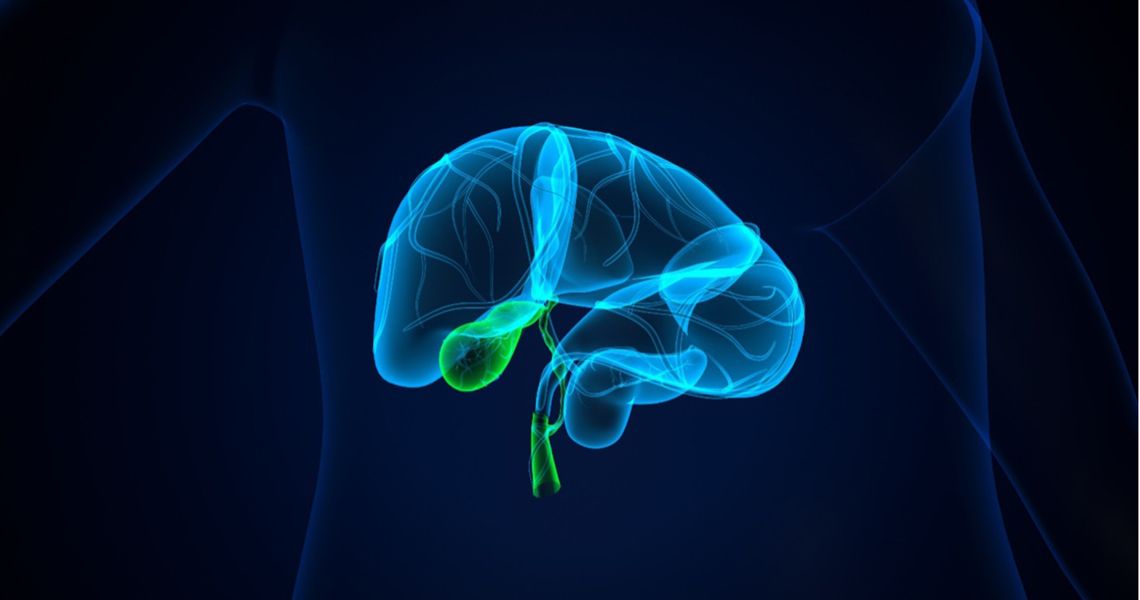February is Gallbladder and Bile Duct Cancer Awareness Month. Fayez Estephan, MD, specializing in gastrointestinal cancers at the GW Cancer Center, explains the various aspects of gallbladder and bile duct cancer, including risk factors, symptoms, diagnosis, treatment options, prognosis, and prevention strategies.

GW Cancer Center
What is gallbladder and bile duct cancer?
Gallbladder and bile duct cancer, though relatively rare, are aggressive forms of cancer that affect the digestive system. These cancers often pose a significant challenge due to their advanced-stage diagnosis and, historically, limited treatment options.
Gallbladder and bile duct cancer originate in the tissues of the gallbladder or bile ducts, which are essential digestive system components. The gallbladder, a small pear-shaped organ located beneath the liver, stores the bile produced by the liver. Bile ducts are tubes that carry bile from the liver to the small intestine by way of the gallbladder. Bile is critical for digesting food, particularly fats. Cancer can develop in either of these structures, leading to potentially life-threatening conditions.
It’s important to keep in mind that even though the bile ducts are located within the liver, this is not hepatic (liver) cell cancer – it’s cholangiocarcinoma, which has an entirely different histology, genetics, and molecular structure and has its own treatment protocols.
What are common risk factors for these types of cancer?
Several factors may increase the risk of developing gallbladder and bile duct cancer:
Age: The risk of these cancers increases with age, particularly in individuals over 65, though these cancers are being diagnosed at increasingly younger ages.
Gender: Women are more prone to gallbladder cancer, while bile duct cancer affects both men and women equally.
Cholelithiasis (Gallstones): The presence of gallstones, which are hardened deposits of digestive fluid that form in the gallbladder, especially larger ones, raises the risk.
Chronic inflammation: Conditions such as primary sclerosing cholangitis (PSC) or chronic gallbladder inflammation can contribute. With PSC, the bile ducts inside and outside of the liver become inflamed and scarred, which can cause the bile ducts to become blocked. Cirrhosis of the liver is also a contributing factor.
Congenital abnormalities: Certain congenital conditions affecting the gallbladder and biliary system (bile ducts) may increase the risk.
Metabolic Syndrome: Patients experiencing metabolic syndrome (a cluster of conditions that appear together), which in these cases include obesity, diabetes, hypertension, and hyperlipidemia (elevated lipid levels), are more prone to these cancers.
What are the typical symptoms of gallbladder and bile duct cancer?
These cancers are tricky because the symptoms frequently only appear when the cancer is at a later stage. Often, gallbladder cancer is incidentally discovered during surgical removal of an infected or inflamed gallbladder. If any of the following symptoms occur, contact your doctor immediately. The earlier gallbladder and bile duct cancers are detected, the better the outcome.
- Jaundice (yellowing of the skin and eyes)
- Abdominal pain and discomfort, particularly in the right upper part of the abdomen
- Unexplained weight loss and loss of appetite
- Nausea and vomiting
- Fever and fatigue
How is gallbladder and bile duct cancer diagnosed?
Again, this is somewhat tricky because these cancers don’t show symptoms at the early stages and are more often discovered at an advanced stage. It’s not uncommon for these cancers to be diagnosed incidentally, for example, when a patient goes to their primary care physician for routine blood work and the liver enzymes are abnormal. When we’re diagnosing gallbladder and bile duct cancer, there is a combination of medical history review, physical examination, and diagnostic tests.
- Imaging tests: CT scans, MRIs, and ultrasounds help visualize the organs and detect abnormalities.
- Biopsy: A tissue sample examined by a pathologist under a microscope is needed to confirm the presence of cancer cells.
- Blood tests: Elevated levels of certain enzymes and tumor markers may indicate liver, gallbladder, or bile duct problems.
What are available treatment options for these cancers?
Treatment approaches depend on the cancer location, stage, and the patient’s overall health. The outcome is favorable for earlier, localized stages, and the cure rate is higher.
Each new diagnosis is reviewed by our tumor board, which includes medical, radiation, and surgical oncologists, interventional gastroenterologists, radiologists, and a pathologist who specializes in hepatobiliary and GI tract cancers. Following this review, we then recommend a treatment plan that can include:
- Surgery: Removal of the gallbladder (cholecystectomy) or affected parts of the bile duct may be recommended.
- Radiation therapy: High-energy rays target cancer cells and may be used before or after surgery.
- Chemotherapy: Powerful drugs used to kill cancer cells or prevent their growth.
- Targeted molecular therapy: A personalized therapy that targets specific, actionable mutations in cancer cells to control how these cells grow, divide, and spread.
In selective cases, there’s the option of delivering chemotherapy or performing radioembolization (a type of radiation therapy used to treat liver cancer or cancer that has spread to the liver) via a catheter to directly target the bile duct tumor when it’s located in the body of the liver. This procedure is performed at the GW Cancer Center.
What is the prognosis for individuals diagnosed with gallbladder and bile duct cancer? How does the stage of the cancer impact prognosis?
The prognosis for gallbladder and bile duct cancer varies based on the stage at diagnosis and the effectiveness of treatment. Unfortunately, these cancers are often diagnosed at advanced stages, making successful treatment challenging. Regular follow-up care is crucial for monitoring recurrence and managing potential complications.
Within the past two years, though, the FDA approved two immunotherapy drugs that can be combined with chemotherapy. Immunotherapy is not a medication that suppresses the immune system; it’s actually the other way around. These medications enhance the patient’s own immune cells to recognize (target) the cancer cells and kill them. Combining immunotherapy and chemotherapy has shown improvement in patient survival.
Can these cancers be prevented? Are there lifestyle changes that can reduce the risk?
While it may not be possible to prevent gallbladder and bile duct cancer entirely, certain measures can help reduce the risk:
- Maintain a healthy weight and lifestyle.
- Eat a balanced diet with plenty of fruits and vegetables.
- Exercise regularly.
- Seek prompt medical attention for gallbladder or digestive system issues.
- If you smoke, try to reduce the number of cigarettes you smoke or quit smoking altogether.
Gallbladder and bile duct cancer present significant challenges due to their late-stage diagnosis and limited treatment options. Awareness of risk factors, early detection, and a comprehensive approach to treatment are crucial for improving outcomes. By understanding the symptoms and taking proactive steps toward prevention, individuals can contribute to their overall health and well-being. Regular check-ups and consultations with healthcare professionals are pivotal in managing and addressing these potentially life-threatening conditions.




